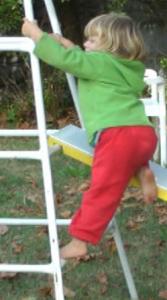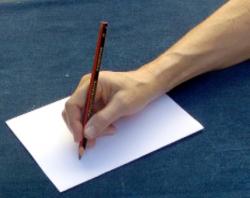And the different ways we use our hands to grasp, hold, move and manipulate objects
Toddlers and children with movement conditions such as joint hypermobilty, low muscle tone, developmental coordination disorder, dyspraxia, Down's syndrome and autism often have difficulties performing everyday fine motor tasks that require good hand and wrist muscle strength and coordination.
Different hand tasks have different coordination and strength requirements
Different hand tasks use a different combination of movements of the fingers and wrist, so that the coordination and strength requirements differ from task to task.




Because the coordination, grasp and manipulation patterns and the strength requirements are specific to the particular hand task, the most effective way to improve hand function is to base exercises on everyday hand tasks. This approach is referred to as functional strength training.
Muscles become stronger when they are made to work harder than usual. This is known as the overload principle. In functional strength training the overload principle is applied by adapting the task to increase the resistance the muscles need to overcome, as well as amount of work done by increasing the number of repetitions or rate of work.
Adapting exercises to avoid stressing joints
Generalized joint hypermobility is a common reasons for weakness of the wrist and hand muscles. The small joints in the thumb and fingers of hypermobile individuals are easily overextended. One of the benefits of functional strength training for the hand is that individuals learn to adapt the grips used for different tasks so that the thumb and finger joints are not overstretched.
Important note Exercises for children who have very hypermobile hands (Ehlers Danlos - Hypermobility Type) and who experience pain in the thumb and finger joints should be overseen by a physical therapist who can advise on joint protection measures.
Many activities that require a grasping an object between the thumb and the fingers. In hypermobile hands this leads to overextension of the finger and thumb joints. Pencil grip can be adapted to avoid overextension.


Principles of strength training
The 10 repetitions to fatigue rule
Muscles get stronger when they are made to work against a load that is at least 60-80 % of their maximum capacity. If a group of muscles can do an activity against a load just 10-12 times before they are tired, then you know that the load is good for increasing strength. This is the 10 repetitions to fatigue rule.
You know that the muscles are tiring when the movement becomes slower and is not being performed smoothly. Another indication of tiredness is a tendency to start using momentum to overcome the load.
Terminology: repetitions, sets and sessions
Repetitions refers to the number of times an action/exercise is repeated. Repetitions are grouped together in sets.
A session refers to the training period for a specific day.
Tasks that use a hook grip
A hook grip is used to grasp objects with a small diameter. The fingers are bent at all the joints.

A hook grip is used for holding a bucket and hanging from an overhead bar. .
Carrying a bucket partially filled with water
Instructions
- Partially fill a bucket with water or beanbags.
- The weight of the bucket should be such that is requires some effort to lift and carry it.
- Carry the bucket across the room and place it on a chair.
- If this is easy, add more weight and carry the bucket across the room again.
Making mud pies and watering the garden
Young children enjoy fetching water in a bucket as part of games or activities in the garden.
Power grip
A power grip is used to grasp and hold a cylindrical object between the fingers and the the thumb. Notice the gap between the thumb and the forefinger, as well as the position of the thumb joints.
Many power grip activities also involve movements of the wrist or elbow to move the lift, tip or tilt the object. When picking up an object using a power grip, the grasp force needs to be carefully adjusted to ensure that the object is firmly held and does not slip out of the hand as the object is moved.


Picking up and pouring from a bottle or beaker
The bottle is grasped by wrapping the fingers around bottle and maintaining the hold as it is lifted and tipped. The size of the bottle or beaker is important - it should allow the bottle to be held between the thumb and forefingers without overstretching the thumb joints.
Picking up and tipping a bottle also strengthens the shoulder muscles and trains coordination.
Instructions
- Fill the bottle with water.
- Carefully pour the water into a jug without spilling any.
- Pour the water back into the bottle.

Carrying a beanbag on a tube
Instructions
- For this activity you will need a cardboard tube with a diameter that allows the child to grasp it easily, and a few beanbags.
- Hold the tube upright with the arm close to the body and the elbow bent.
- Balance a beanbag on the top.
- Keep the tube steady and see how many beanbags you can pile one on top of the other.
- Can you walk across the room carrying the pile of beanbags?

Picking up a bottle with a handle
Instructions
- Use a bottle with a handle for this activity
- Depending on the size of the bottle, partially fill the it with water. Place the bottle on a table next to a box.
- Lift the bottle up onto the box, and then move it back onto the table again. Do this movement 10 times.
- Adjust the weight of the bottle as needed, using the 10 reps to fatigue principle.
Pouring from a bottle with a handle
Instructions
- Use a bottle or jug with a handle for this activity.
- Partially fill the bottle with water to increase the weight so that it requires some effort to lift and tip it in a smooth manner.
- Pick the bottle up by the handle and pour the water into a jug or other container.
- Refill the bottle and repeat the exercise several times.


Climbing on a climbing frame
Climbing activities require a strong power grip to support the weight of the body.
Provide your child with opportunities to play on a climbing frame to strengthen all the muscles of the hands and arms.

Raking and sweeping require a strong grip
Raking and sweeping is another fun way to work on arm and hand strength. Younger children may need a smaller rake.
Indoors you can use a small rake for pushing and pulling weighted boxes or bottle across the floor. 
A palmar grasp
A palmar grasp is used to hold objects or tools with a long handle The handle of the tool is held diagonally across the palm of the hand. The thumb is used to stabilize the grasp. In some tasks the thumb is used along the length of the object, such as when holding a hammer.
Hammering with a hammer
Depending on the size of the hammer, either wrist or elbow movements are used to move the head of the hammer up and down. The weight of the hammer provides the overload needed for improving strength. Repeated hammering actions help to improve endurance.

Making circles with a hammer
Instructions
- For this activity you will need to make a hammering pad; you can do this by taping together several layers of corrugated card.
- Bringing the hammer down hard on the card produces a circular indent.
- Cover the hammering pad with circles.
Pouring from a saucepan with a long handle
The handle of the pot rests across the palm of the hands. To pour from the pot that forearm is twisted.
Instructions
- Choose a cooking pot that can be easily be picked up and held for 10 seconds.
- Pour a little water into the pot.
- Hold the pot steady for 10 secs.
- Next tip the water into another container.
- To increase the load, increase the amount of water in the pot.
Digging with a trowel and spooning with a tablespoon
Young children use a palmar grasp when using a spoon to for eating or picking up rice or sand with a spoon. A palmar grasp is also used when digging with a trowel.
Spooning rice or sand
Instructions
- Half fill a pan or plastic container with rice or sand.
- Use a spoon or small spade to move the rice or sand into another container.
- A bigger spoon or spade will hold more rice or sand, which means that the muscles have to work harder to grasp, pick up and move them.
Digging with a trowel
Instructions
- This is a good activity for the garden or sandpit.
- Use a garden trowel to do the digging. This has a short handle but large blade so that more sand can be lifted at a time.
- Use the trowel to pick up and move sand into a bucket or to make a large pile of sand.
- Wet sand is heavier making the activity more difficult.
A spherical grip is used with round objects
A spherical grip is used when the fingers need to be shaped to grasp a round object. This grip is used to grasp a ball shaped or flat round object, such as the lid of a tub.


Grasping and lifting a heavy jar
Instructions
- In this activity you grasp the lid of jar and pick it up.
- Fill the jar with water to make it heavier. The weight needs to adapted so that you can lift the jar and then tip it so that it is horizontal, and maintain this position for 15-20 secs, but not much longer.
- You can also practice holding the forearm steady and lifting and lowering the jar using a wrist movement.


Screw and unscrew a jar lid
When unscrewing the lid of a jar, one hand is used to stabilize the jar - this action requires a power grip. The fingers of the other hand grasp the lid of the jar firmly, and then use a movement of the forearm to loosen the lid.
Once the lid is loose, small sideways movements of the fingers are used to twist the lid several times. More about screwing and unscrewing lids to strengthen the fingers. Read more: screwing and unscrewing lids for finger strength

A lumbrical grip
A lumbrical grip is used to hold an object without wrapping the fingers around it. .The fingers need to be straight, rather than curved.
The forearm muscle contract to bend the knuckle (metacarpophalangeal) joints and the small hand muscles hold the fingers straight. This grip is difficult to maintain if the small hand muscles are weak. .


Holding a book upright
Instructions
- In this exercise a book is held upright in front of the body.
- You will need one book that has a hard cover, is about 2 cm thick and can easily be held upright
- You also need two smaller lighter books that can be balanced on top of the upright book.
- Stand erect and hold the hardcover book upright in front of the body, with the elbow bent.
- See how many books you can balance on top of the upright book.

A pincer (precision) grip
Small objects are picked up between the tip of the thumb and forefinger. From 8-10 months of age infants use this grip to pick up small objects.
The thumb is held at right angles to the palm and is straight. The small joints of the fingers are bent.

This position of the fingers is difficult for individuals with hypermobile finger joints. The small joints of thumb and forefinger tend to hyperextend, especially when some degree of force is needed. It is best to use an adapted grip when force needs to be applies to a small object. The object is picked up between the tip of the thumb and the side of the forefinger - this is often called a key grip. See below.
Stretching a rubber band
Instructions
- You will need one or more sturdy rubber bands for this activity.
- Grasp the rubber band on each side between the tip of the forefinger and the thumb.
- Move the hands apart to stretch the rubber band as far ae it will go.
- Maintain this stretched position for 15-20 secs.
- If you are able to hold the fully stretched band easily for 20 seconds, try holding and stretching two bands.
Making BluTack (Prestick/Tack It) balls
- Break a piece of Blu Tack into pea sized pieces. You need enough putty to make 20 pieces.
- Roll the pieces into small balls between your forefinger and thumb.
- Use the balls to mount pieces of colored paper to a piece of card to make a mosaic.
A key grip
Many activities involve gripping a small flat surface between the thumb and side of the forefinger. The other fingers are flexed to provide additional support. This combination of movements allows considerable force to be applied to the object.
A key grip is used to turn a key, when tearing paper, lifting up a box by grasping on the sides. pulling on Velcro fastenings, pulling up trousers and socks.

Picking up a box
Instructions
- Use a cardboard or plastic box with straight sides, about the size of a shoe box, for this activity
- You will also need several books that can lie flat to act as weights.
- Put the box on chair with 2 books inside.
- Grasp the box using a key grip and lift it up to about chest height and hold it there for 20 secs.
- Put the box back down on the chair.
- If the box can be lifted and held easily, add another book to make it more difficult to hold the box up for 20 secs.
- Keep adding books until holding the book up for 15 secs is very hard work.
Swinging a sock sand bag
- Half fill a sock with sand, beans or rice.
- Tie a knot at the top of the sock
- use a key grip to grasp the sock by the knot and lift the hand forwards to chest height with the elbow bent.
- Swing the sock backwards or forwards, or round and round 20 times.
- If it is easy to hold and swing the sock beanbag 20 times. add some snad to the bag to make it heavier.
A chuck grip
Tools, such as a spoon or knife are often grasped using the thumb, fore- and ring finger.
The fingers need to firmly grasp and stabilize the tool while at the same time move to manipulate it. This is a complex action which young children only start to effectively master at 4-5 years.
A chuck grip is used to hold and manipulate a spoon, unscrew small lids.
A tripod grip
A tripod grip is used for holding a pen when drawing and writing
A good pencil allows the child to hold the pencil in the hand in such a way that small movements of the fingers and wrist can be used to move the pencil point in all directions on the paper.
The three finger tripod grip the most common configuration: the pencil is stabilised between the thumb and the side of the index and middle fingers.
- The ring and middle fingers rest lightly in the palm of the hand.
- The wrist is held straight (in extension).
A good grip allows the child to make small bending and straightening movements of the fingers.
;
In this short video you see how I use a combination of small finger movements, combined with small wrist movements to draw short lines in different directions. TIP: Click on the gear to for slow motion playback.
The position of the thumb varies
Some children adopt a typical tripod grip with the thumb held away from the index finger with a gap between the thumb and index finger.
The thumb may also be held close to the index finger (thumb adduction). This position is commonly seen in children with hypermobile fingers. (More about thumb position)


More about hand function
How to assess your child's pencil grip and finger movements
How drawing in kindergarten improves motor control and endurance
Disclaimer
The content on this site is provided for general information purposes only and does not constitute professional advice.
All liability is excluded to the fullest extent permitted by law in respect of any loss or damage whether direct, indirect or consequential that arises in connection with the use of or reliance upon any content forming part of this site.








